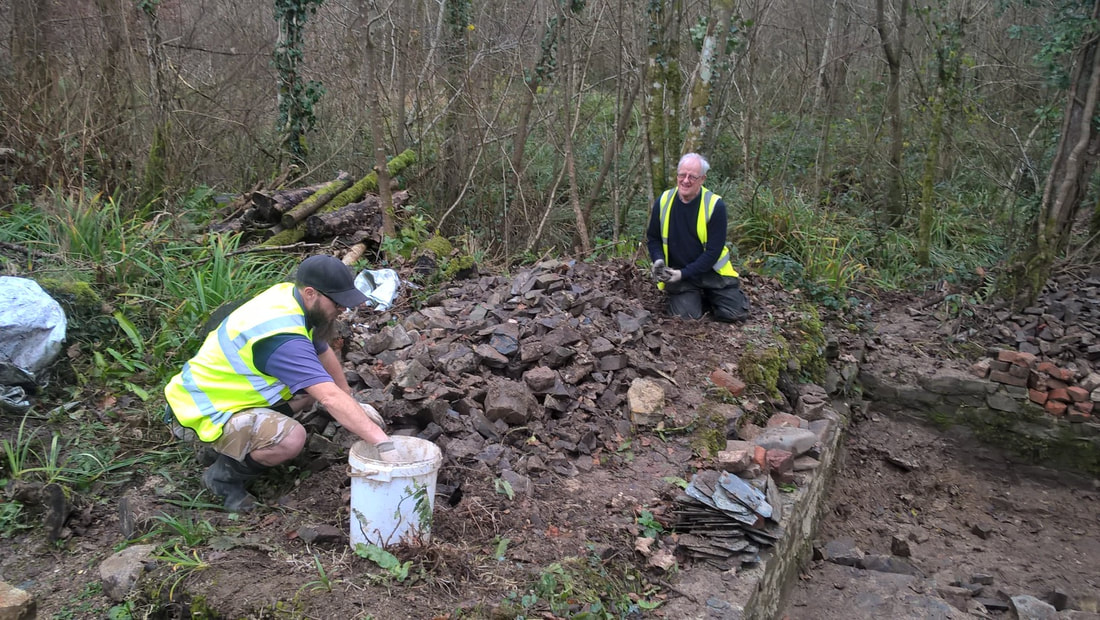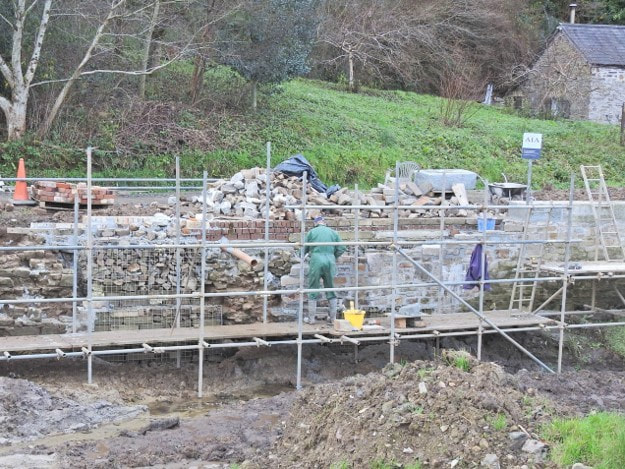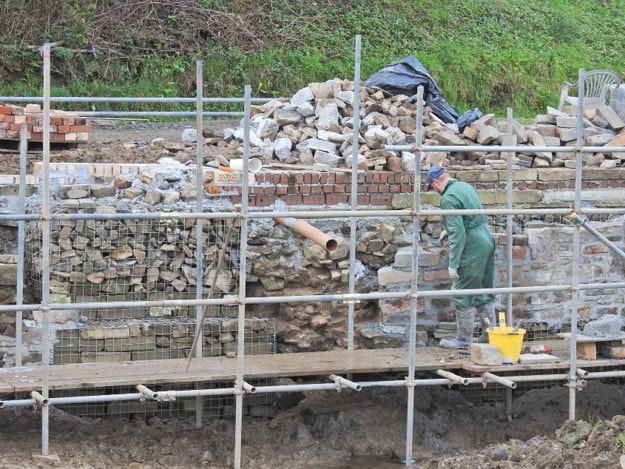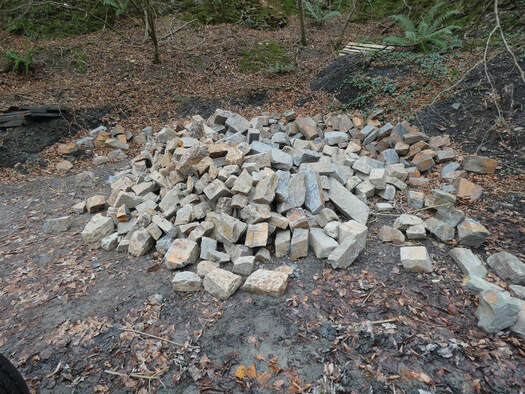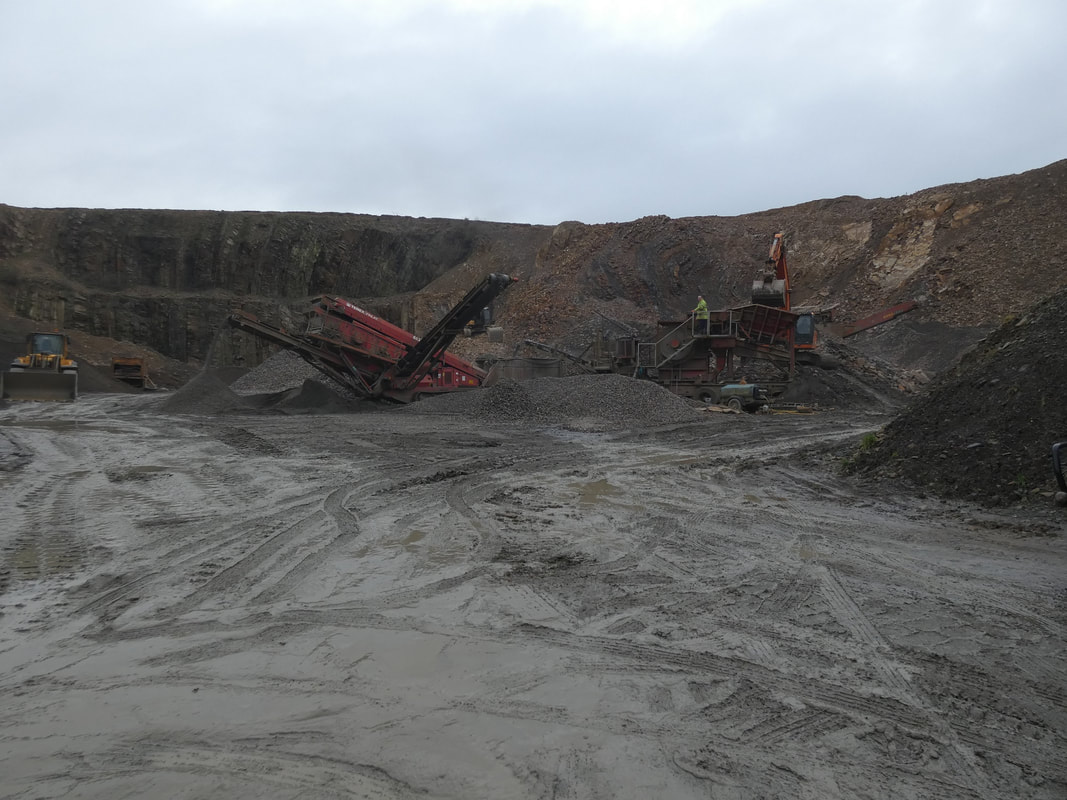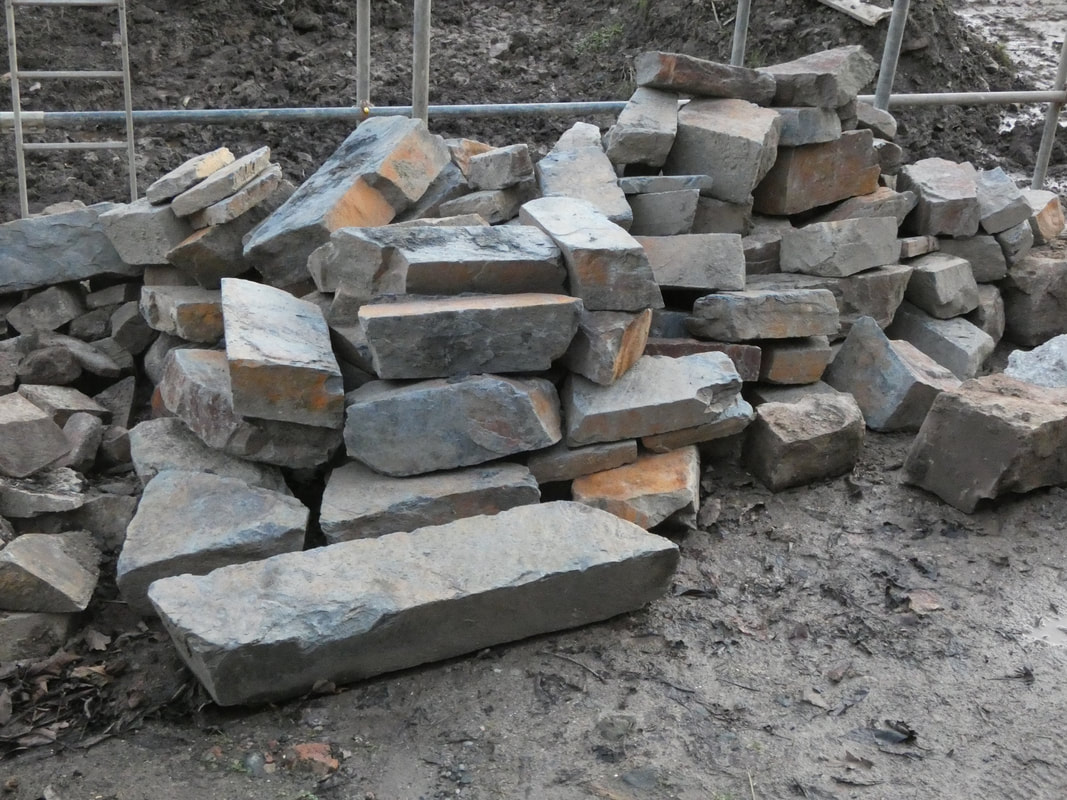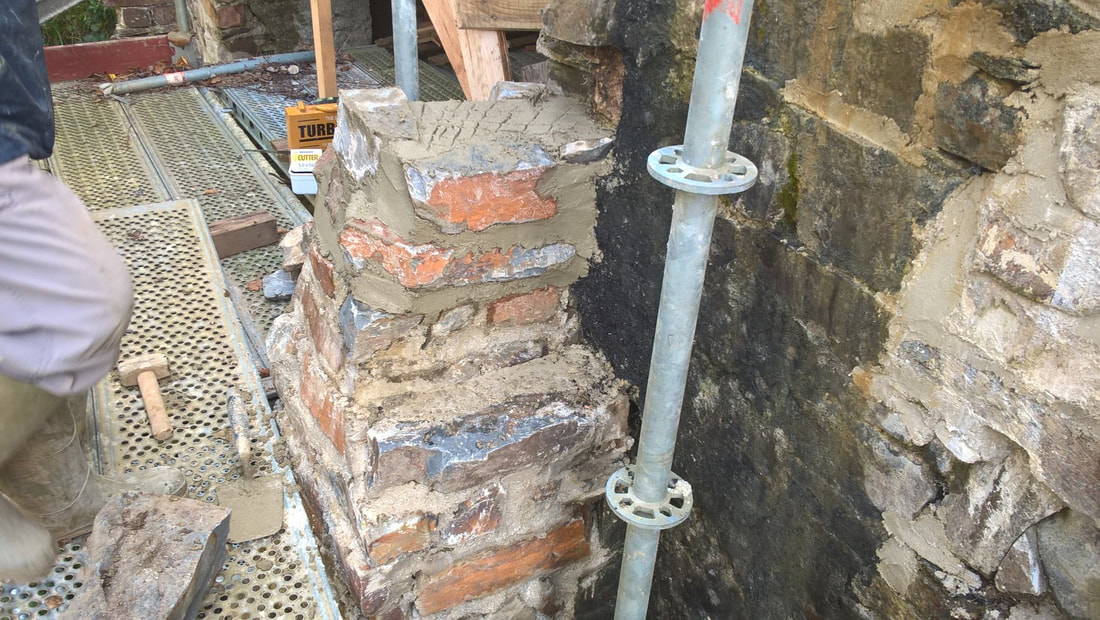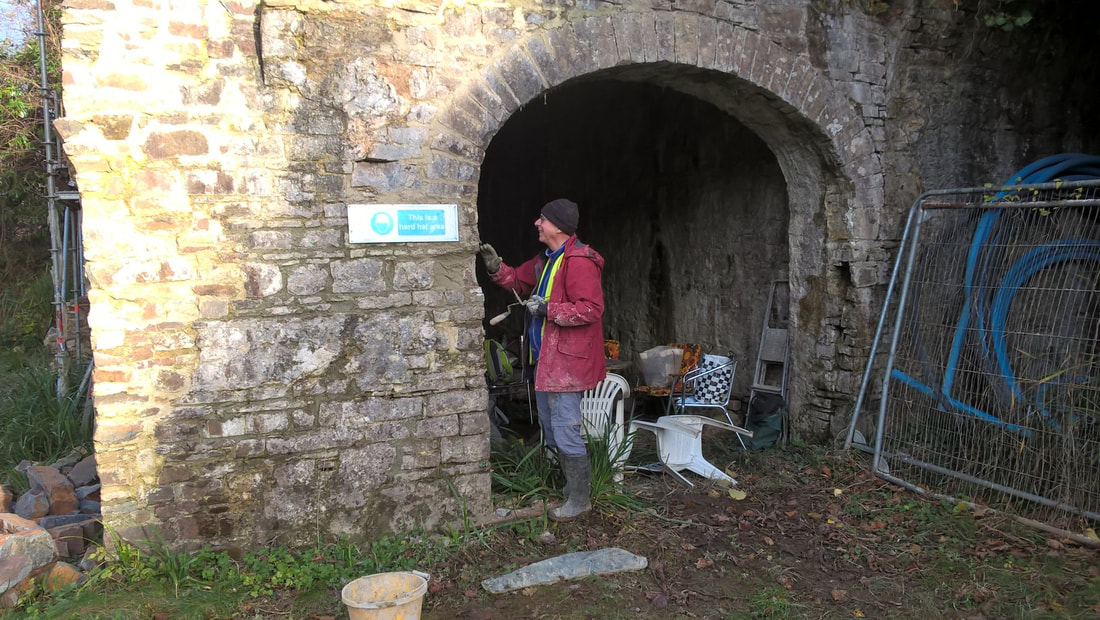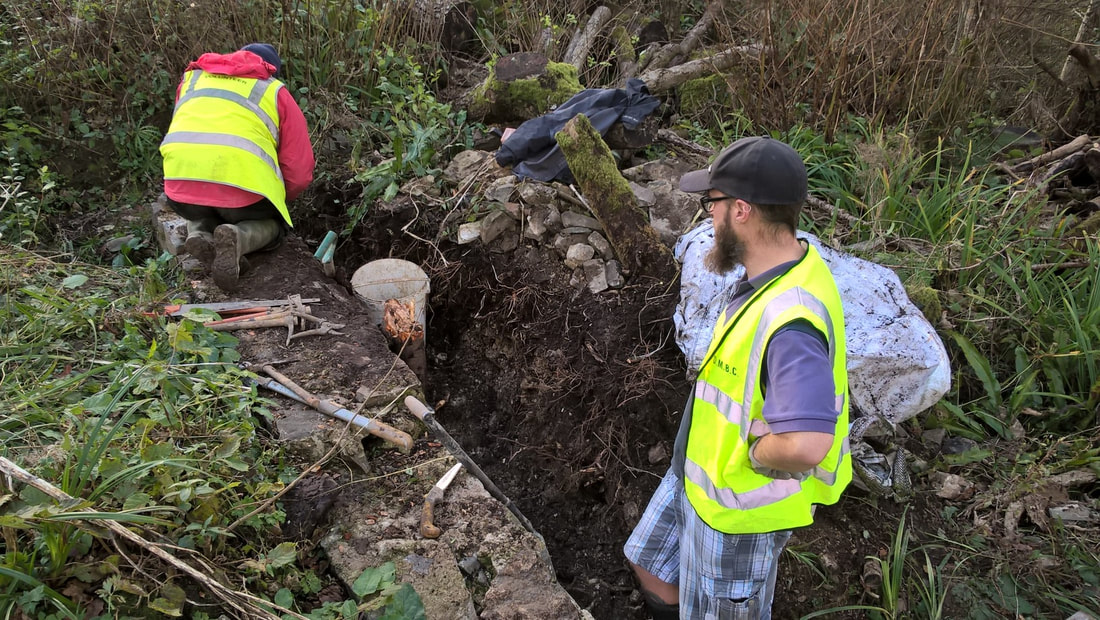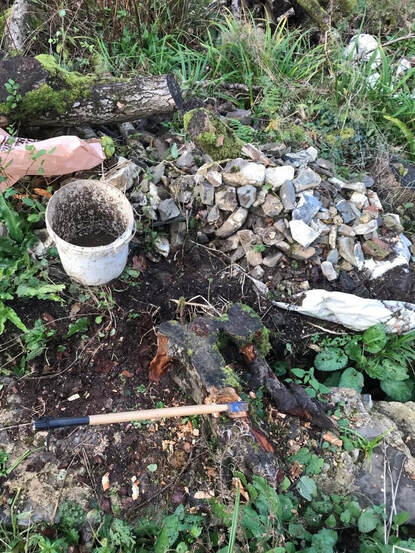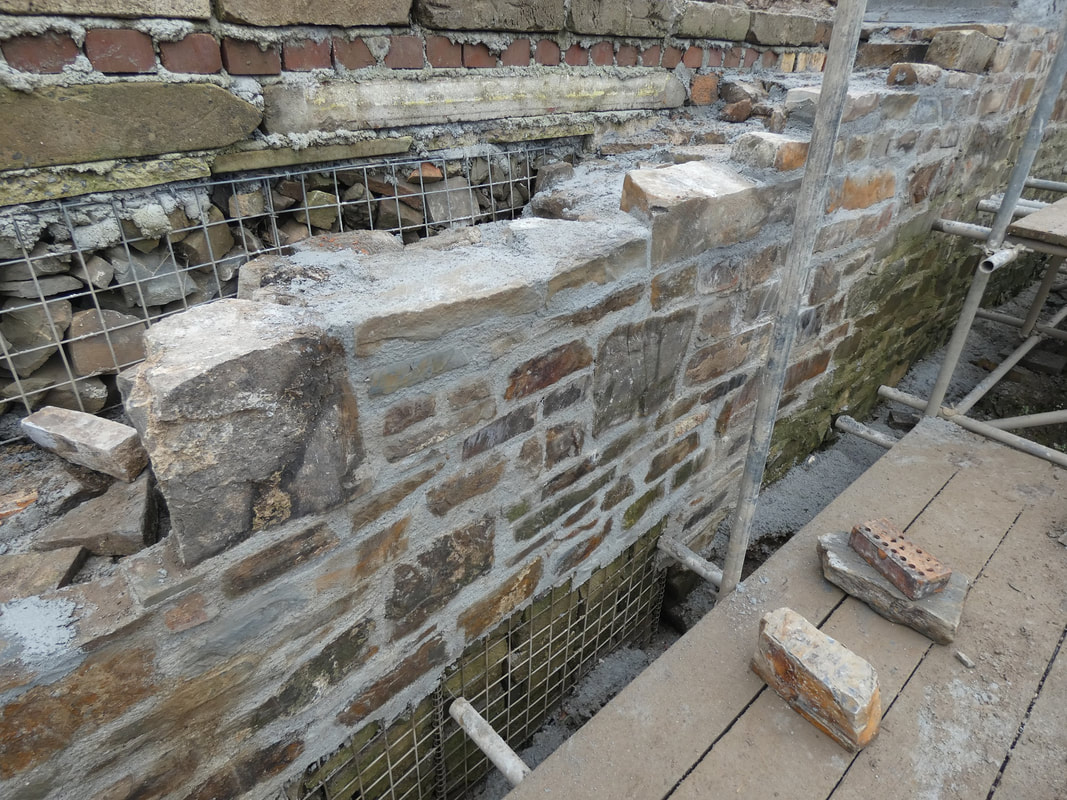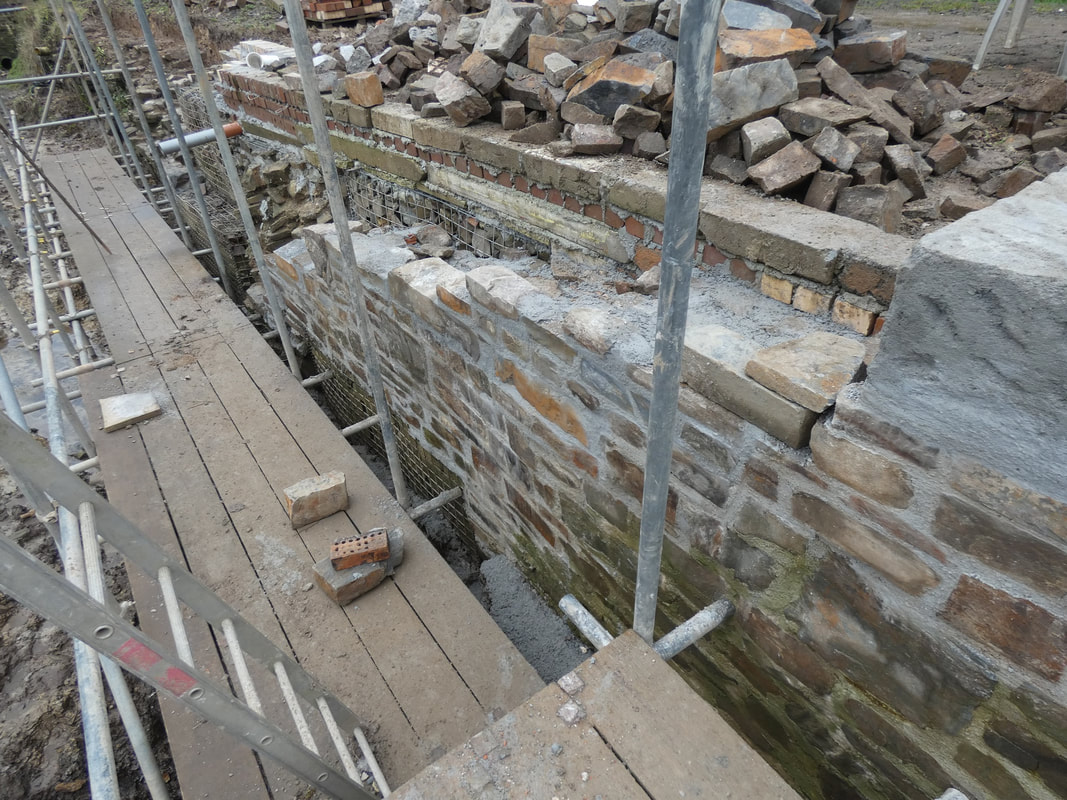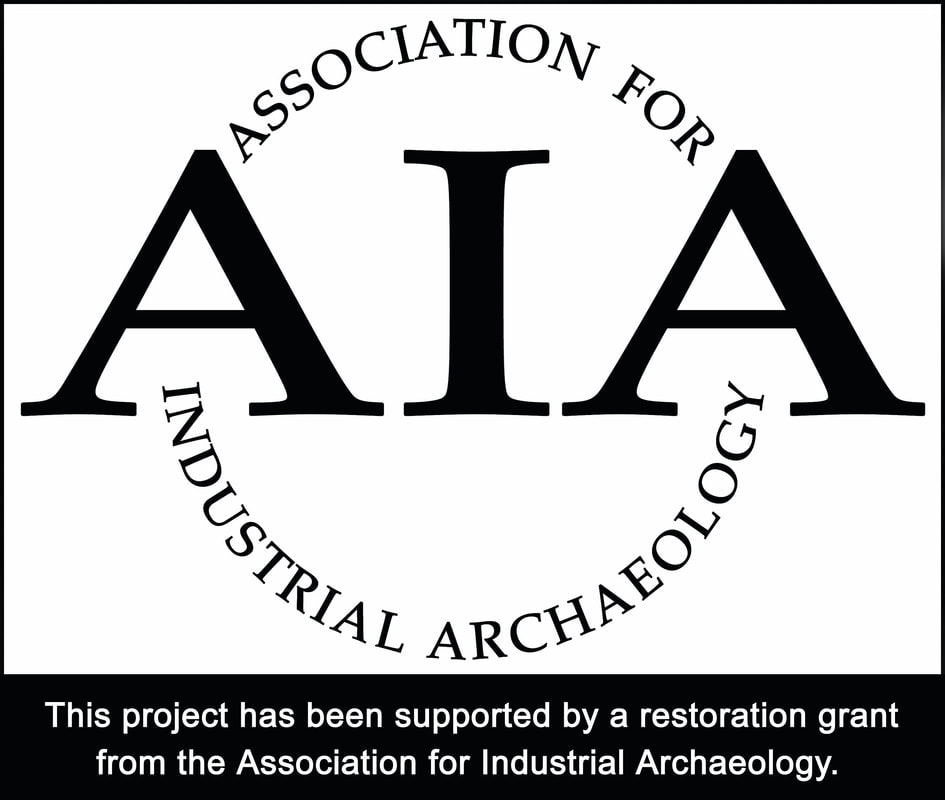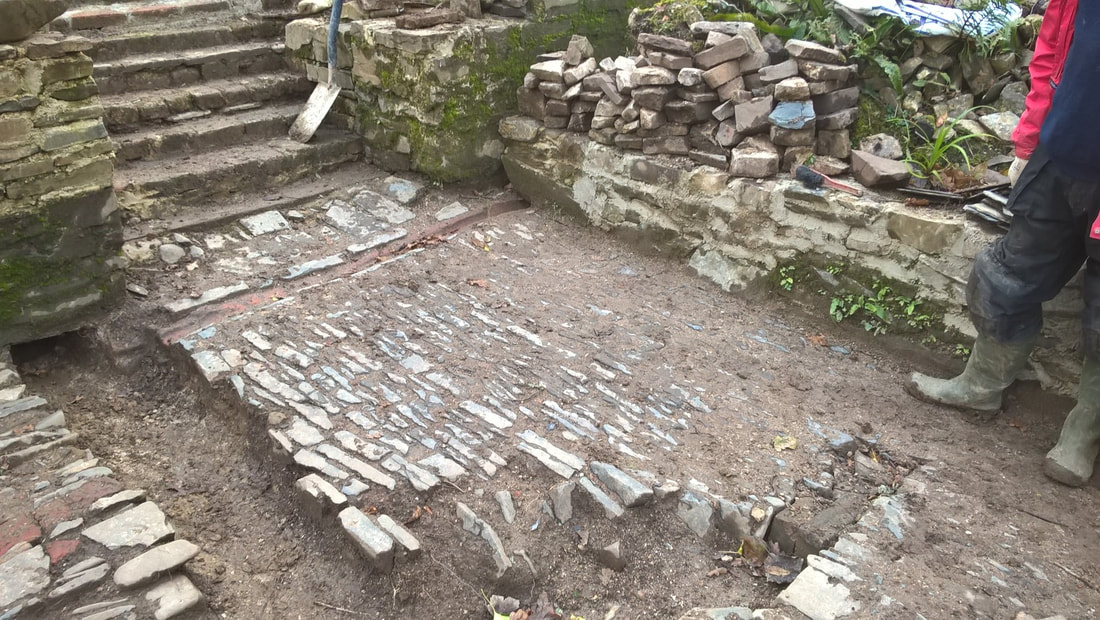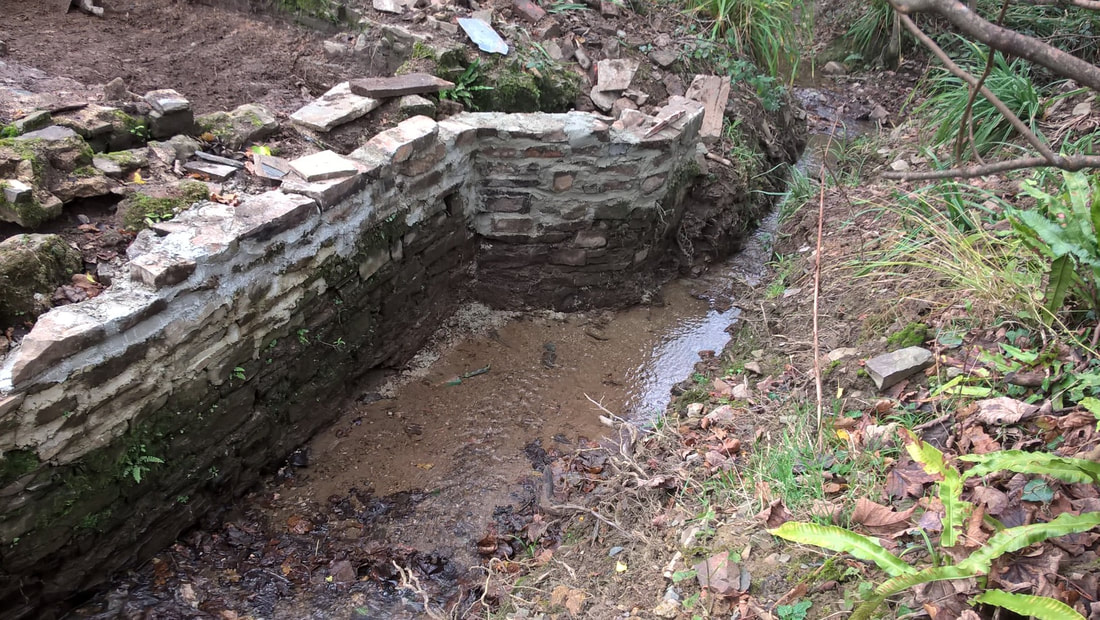December News
ROSEMOOR RESTORATION REPORT by Tony Nicholls - 15th December 2021
This was our final working session of 2021 at Rosemoor. Looking back, it seems impossible that another year has passed but the calendar does not lie!
This was our final working session of 2021 at Rosemoor. Looking back, it seems impossible that another year has passed but the calendar does not lie!
Upper basin in water
Our masons continued to rebuild the left hand buttress adjacent to the main arch of the lime kiln. This will provide a sound base on which to reconstruct the arch itself – a task to which we will return in the New Year.
Repairing the left buttress
Tucking mill - lower chamber
The project manager, his mood obviously lightened by the approach of the festive season, allowed the rest of the team to do some gentle stone picking in the tucking mill. During the year, we have amassed a substantial pile of stone from our excavations and we needed to sort this into good stone (i.e. stone with one good face suitable for rebuilding the foundation walls) and rubbish. The transformation of the tucking mill which was previously completely buried under tons of earth has been truly remarkable.
Sorting the stone
We left the canal in water for the Christmas break and adjourned to The Cavalier Inn in Torrington for an excellent Christmas lunch reflecting on a year in which a great deal of solid progress has been made on the Rosemoor site.
Lower basin in water
Generally working parties are held every Wednesday morning, meeting in the main car park at RHS Rosemoor, Torrington at 9.30am. (.NB. Arrangements may vary during Covid restrictions). Please contact Project Manager, Ian Harrison (tel.01237- 475707) for more information.
|
Sea Lock reports by Adrian Wills - 17th December 2021
NOT QUITE 'BILLY NO MATES' The working party at Sea Lock today (Tuesday, 14.12.21) was reduced to 2 – Steve and myself! However we soon got our act together, got a load of mortar mixed and began laying stones. Having to keep climbing up and down the ladders on the scaffold lift in order to select suitable stones from the pile on the side of the towpath above where we were working, along with buckets full of mortar, was slow going but by the end of the day we never-the less had consumed a large amount of material and managed to infill a considerable space between the facing and rear skins of the wall. |
I have to say that I’m very impressed with Steve’s masonry skills but I’m not too sure about his occasional; singing!
|
GOING UP AND COMING DOWN
On Thursday (16th) I worked with Trevor again. He doesn’t sing. Whilst I carried on rebuilding, he worked on scraping mud from the old broken masonry further along the wall, in preparation for new stone work to be re-laid. As fast as I managed to lay new stone Trevor was happily removing old stone. Over the years the lime mortar has been leached out from the stone work and soil had worked its way into the gaps left behind and loosening the stones. Trying to get back to a fairly stable surface is often quite difficult. Trying to rebuild the front edge of the wall in a vertical and straight line is also very difficult. The thickness of the wall varies quite considerably and the masonry has settled and moved over the passage of time. In some ways it might have been simpler to take the whole wall right down to its foundations (if it actually has any?) and start again from scratch. This, of course, would be a tremendous undertaking and a very long termed task. I have already been working on rebuilding sections of Sea Lock since the late 1990’s and I often joke about it as being a life-sentence.
Sadly I don’t think I could manage another 20 years!
On Thursday (16th) I worked with Trevor again. He doesn’t sing. Whilst I carried on rebuilding, he worked on scraping mud from the old broken masonry further along the wall, in preparation for new stone work to be re-laid. As fast as I managed to lay new stone Trevor was happily removing old stone. Over the years the lime mortar has been leached out from the stone work and soil had worked its way into the gaps left behind and loosening the stones. Trying to get back to a fairly stable surface is often quite difficult. Trying to rebuild the front edge of the wall in a vertical and straight line is also very difficult. The thickness of the wall varies quite considerably and the masonry has settled and moved over the passage of time. In some ways it might have been simpler to take the whole wall right down to its foundations (if it actually has any?) and start again from scratch. This, of course, would be a tremendous undertaking and a very long termed task. I have already been working on rebuilding sections of Sea Lock since the late 1990’s and I often joke about it as being a life-sentence.
Sadly I don’t think I could manage another 20 years!
STILL QUIETLY GROWING
Sea Lock report by Adrian Wills - 15th December 2021
The working party at Sea Lock on Tuesday (14.12.21) was reduced to a slender group of 2, namely Steve and me. However we soon got our act together, mixed a load of mortar and began laying stones.
Sea Lock report by Adrian Wills - 15th December 2021
The working party at Sea Lock on Tuesday (14.12.21) was reduced to a slender group of 2, namely Steve and me. However we soon got our act together, mixed a load of mortar and began laying stones.
Having to keep climbing up and down the ladders on the scaffold lift in order to select suitable stones from the pile on the side of the towpath above where we were working, was a trifle tedious and hindered our rate of progress. Humping buckets full of mortar also kept us busy. However by the end of the day, having used up a significant amount of materials especially on infilling the space between the front skin of the wall and its back edge, we left the site reasonably happy with what we had achieved.
Although not exactly sunny, the weather had been fairly kind to us. It had kept dry and was relatively warm especially for the time of year! Great for helping the mortar setting.
|
FULL 'STREAM' AHEAD?
Alternatively - More chips off the old block Sea Lock report by Adrian Wills - 10th December 2021 The weather forecast for Thursday (09.12.21), being reasonably good for the day, finally allowed Trevor and me to take my Land Rover and trailer to the local quarry in order to collect some facing stone. We were pleased to find a substantial pile of stone had already been selected as suitable for wall building although much was random faced. However we managed to pick out some pieces which will be perfect for our purpose. |
We couldn’t get an exact weight because the Land Rover and trailer were too long to fit on the quarry’s weigh bridge but judging from the bulge on the tyres we certainly had a good quantity on board.
On returning to Sea Lock the next task was clearing a space close enough to where the stone was to be used and then unloading the trailer. It had to be emptied because the next job was to collect a load of grit sand to replenish my rapidly diminishing supply. This was finally accomplished so then we set off to the near-by supplier of aggregates and collected the sand. On our way back to the site for the second time that day, we stopped at a builders merchants to collect 5 bags of cement. Previously in the week I had bought 3 more bags of hydraulic lime so we were now fully prepared for a building extravaganza, subject, of course, to some forth-coming dry and not too cold weather!
By the time we got back to the site it was raining quite hard (again!) so we decided to call it a day.
ROSEMOOR RESTORATION REPORT by Tony Nicholls - 8th December 2021
The last vestiges of Storm Barra were still buffeting the Rosemoor site when we arrived this morning. Fortunately, the basin is reasonably well sheltered and the winds had abated by the time we started work but it was still decidedly chilly.
On the lime kiln, the wooden former has now been completed and is ready for the rebuild of the arch. In preparation for this, the right hand buttress has been built up to provide a solid platform for the base of the arch masonry. It is only when you get close up that you begin to appreciate how much stone has been removed from the face of the arch and how badly degraded the structure is. The fact that the whole thing has not collapsed (at least not yet!) is something of a miracle.
The last vestiges of Storm Barra were still buffeting the Rosemoor site when we arrived this morning. Fortunately, the basin is reasonably well sheltered and the winds had abated by the time we started work but it was still decidedly chilly.
On the lime kiln, the wooden former has now been completed and is ready for the rebuild of the arch. In preparation for this, the right hand buttress has been built up to provide a solid platform for the base of the arch masonry. It is only when you get close up that you begin to appreciate how much stone has been removed from the face of the arch and how badly degraded the structure is. The fact that the whole thing has not collapsed (at least not yet!) is something of a miracle.
Finished former in place
The tucking mill is really starting to take shape now with the ongoing re-build of the external walls and further excavation of the interior. In the lower chamber, we uncovered a pipe leading to the duct which we believe allowed waste water to drain into the mill race. An interesting cast iron grate was found here which we are leaving in situ.
|
Drain in tucking mill
We now think that the two large holes in the internal wall may have housed timber baulks onto which the fulling machinery would have been bolted although – as usual – this is just a working theory at present. We also made a start on digging out some of the earth from the third chamber although, predictably, this was hampered by a large tree stump growing over the wall. However, some sturdy lumberjack work with an axe is making inroads into this obstacle. |
Exposed pipe
|
Rebuilding the external wall of the tucking mill
Excavating the third chamber
The rebuild of the final section of the upper basin wall has now been completed and the entire length of wall is ready for capping – a job we hope to undertake in the New Year.
|
Repaired wall - upper basin
We also spent some time cutting back the ever-growing jungle of vegetation which has made a great improvement to the overall appearance of the site and, at the end of the session, did some much-needed repointing of the crumbling masonry in the lime kiln wall. |
Troublesome tree stump
|
Strimmed towpath
Generally working parties are held every Wednesday morning, meeting in the main car park at RHS Rosemoor, Torrington at 9.30am. (.NB. Arrangements may vary during Covid restrictions). Please contact Project Manager, Ian Harrison (tel.01237- 475707) for more information.
A YOUNG AND VERY MUCH SMALLER RELATIVE - Alternatively - a chip off the old block? Sea Lock report by Adrian Wills - 5th December 2021
On Friday (03.12.2021) I had provisionally arranged for Steve, Trevor and me to visit the quarry to select a load of facing stone for Sea Lock. The weather forecast for the day, on the previous evening’s TV broadcast, was not good so we postponed the stone collection until (hopefully) sometime during the coming week.
On Friday (03.12.2021) I had provisionally arranged for Steve, Trevor and me to visit the quarry to select a load of facing stone for Sea Lock. The weather forecast for the day, on the previous evening’s TV broadcast, was not good so we postponed the stone collection until (hopefully) sometime during the coming week.
|
Once again the forecast proved to be incorrect and Friday was relatively dry. Having put-off Steve and Trevor I was somewhat at a loose end so decided to go down the site and try and do something useful.
Having done a little tidying up I then moved the most recently cast coping block, operating the Priestman Cub crane, to near where it would eventually be placed on the wall. The original coping stones are of varying dimensions although much the same in depth so when I initially set about casting my own, I made a conscious decision to keep the depth constant for ease of laying but to vary the length and width of them. I did not want them to look too uniform. The last few blocks that I have laid are of the same dimensions so I decided to cast another of a different size just to make the changes. Having only a little amount of spare time before the weather was forecast to change for the worst on Friday afternoon I set about constructing a small mould ad had soon filled it with mortar and some more empty bottles. This morning I removed the shuttering and as usual, distressed the soft, on-show surfaces. This is a rather ‘cute, Mickey Mouse’ block, relative to its older predecessors but still progresses the restoration process! A lot more are still required however. |
SLOWLY (but steadily and somewhat damply) GETTING THERE - Sea Lock report by Adrian Wills - 4th December 2021
It was a damp and rather dismal day on Tuesday (30.11.2012) but that didn’t deter Steve from turning up early on site, nor Nick who followed shortly and a few minutes later, Michael and Tony.
Michael busied himself with the cement mixer and kept a steady supply of mortar coming to Steve and me. Whilst Steve concentrated on rebuilding wall-facing from the scaffold, I worked on top, extending the back of the wall across the second stone-filled gabions.
This section of retaining wall would originally have been used for supporting a fairly narrow towpath and would not have to support the weight of heavy loads moving along it, probably never more than a horse and cart.
Today the towpath needs to support the transport of heavier, modern machinery including occasionally, large crawler cranes and tracked excavators so it makes sense to widen and strengthen the wall during its reconstruction.
Tony and Nick continued where they left off on their last visit, with the tedious and tiring task of removing debris and loose material from further along the top of the wall. The damp weather makes this task even more onerous than usual due to the heavy and sticky subsoil that needs to be removed.
It was a damp and rather dismal day on Tuesday (30.11.2012) but that didn’t deter Steve from turning up early on site, nor Nick who followed shortly and a few minutes later, Michael and Tony.
Michael busied himself with the cement mixer and kept a steady supply of mortar coming to Steve and me. Whilst Steve concentrated on rebuilding wall-facing from the scaffold, I worked on top, extending the back of the wall across the second stone-filled gabions.
This section of retaining wall would originally have been used for supporting a fairly narrow towpath and would not have to support the weight of heavy loads moving along it, probably never more than a horse and cart.
Today the towpath needs to support the transport of heavier, modern machinery including occasionally, large crawler cranes and tracked excavators so it makes sense to widen and strengthen the wall during its reconstruction.
Tony and Nick continued where they left off on their last visit, with the tedious and tiring task of removing debris and loose material from further along the top of the wall. The damp weather makes this task even more onerous than usual due to the heavy and sticky subsoil that needs to be removed.
However, by lunch time they had made considerable progress and removed several wheelbarrow loads of spoils and were getting back to more stable masonry.
Michael and Tony left at midday having other commitments, leaving Steve and me rebuilding and Nick digging. He had worked up a considerable sweat by this time.
Taking pity on him, I gave him the opportunity to have a break and master the skills of operating the back hoe and front-end loader on the Kubota tractor. After a short explanation of what lever did what, I left him to practise working the machine on a spoil heap further down the site.
Michael and Tony left at midday having other commitments, leaving Steve and me rebuilding and Nick digging. He had worked up a considerable sweat by this time.
Taking pity on him, I gave him the opportunity to have a break and master the skills of operating the back hoe and front-end loader on the Kubota tractor. After a short explanation of what lever did what, I left him to practise working the machine on a spoil heap further down the site.
Steve and I continued building and by the end of the day we had rebuilt quite a bit of facing and rear wall. The weather played against us (it was supposedly going to clear up!) by turning wetter creating problems for laying stone and making the mortar runny.
ROSEMOOR RESTORATION REPORT by Tony Nicholls - 1st December 2021
Another satisfying day at Rosemoor culminated in the discovery of a further section of the toothed iron rim of the former water wheel which our navvies unearthed from the tucking mill. We now have six sections of the rim which make up almost half of the circumference of the wheel which we estimate must have been about 8 feet in diameter.
Another satisfying day at Rosemoor culminated in the discovery of a further section of the toothed iron rim of the former water wheel which our navvies unearthed from the tucking mill. We now have six sections of the rim which make up almost half of the circumference of the wheel which we estimate must have been about 8 feet in diameter.
Waterwheel ironwork
We have now fully excavated the lower chamber of the tucking mill. This has revealed more of the lovely cobbled floor although, sadly, a large part of this has been destroyed or intentionally removed. During this process, two interesting drainage holes were exposed at the bottom of the central wall. Clearly, there was some sort of internal drainage system in the building which allowed water and effluent from the fulling process to be expelled into the mill race. Work on the reconstruction of the external wall which bounded the mill race is progressing well and the whole site is starting to take on definitive form and character.
Tucking mill - general view
Re-built wall of mill race
On the lime kiln, thanks to the efforts of our resident ‘chippy’, an impressive wooden former is being assembled under the main arch. This will support the replacement stonework during reconstruction. This is a daunting task made more difficult by the fact that the ‘sockets’ where stones have been removed are all of different shapes and sizes.
We also took a look at the last section of the retaining wall in the upper basin adjacent to the bund. Unfortunately, this was not in such a good state of repair as we previously thought, the top of the wall being little more than a pile of earth and loose stones. We decided that this had to be removed in order to get down to a solid base to allow us to rebuild. Despite the soggy conditions in this part of the canal, we managed to lay a couple of courses before the end of the session and hope to complete the rebuild next week.
Re-build of upper basin wall
Generally working parties are held every Wednesday morning, meeting in the main car park at RHS Rosemoor, Torrington at 9.30am. (.NB. Arrangements may vary during Covid restrictions). Please contact Project Manager, Ian Harrison (tel.01237- 475707) for more information.




